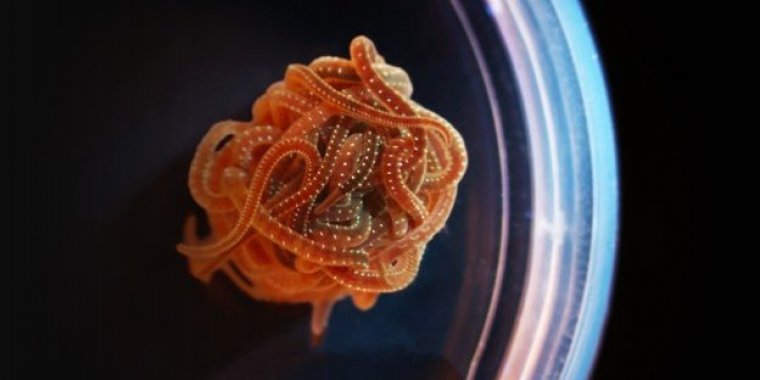| News / Science News |
Shape-shifting worm blobs could inspire future robot swarms
Blackworms, or Lumbriculus variegatus, are distant relatives of earthworms. They live, as individuals usually, in shallow marshes, ponds and swamps in Europe and North America, where they feed on microorganisms and debris. To protect themselves from drought, blackworms can come together as entangled, shape-shifting "blobs" composed of a few to hundreds of individuals. Just like swarms of bees, rafts of fire ants or flocks of starlings, blackworm blobs can show collective movement.

Blob of Lumbriculus variegatus blackworms. The half-circle is the edge of a petri dish. Photo: Harry Tuazon
Now, scientists using physics-based computer models show that collective movement can emerge in blackworm blobs only when conditions are just right -- in particular, when there is a balance between the activity and "clinginess" of individual blackworms.
"Unlike flocks of birds and schools of fishes -- groups of individuals that move together by avoiding each other -- worms touch and entangle to coordinate group movement," said John Long, a program director in NSF's Division of Integrative Organismal Systems.
"These researchers' clever computer simulation shows that worms work well as a unit when each individual finds the right balance of two physical forces, one that governs how they stick together and one that adjusts forward motion.
"Those physical rules may be applied to any situation where human engineers want to coordinate the enmeshed movement of flexible and self-propelled cables, fibers or even worm-like robots."
Interactions between individual blackworms can yield unexpected, novel properties when they move as a blob. Such properties are a feature of hierarchically organized biological systems, from proteins to multicellular organisms to ecosystems.
Therefore, the blobs can also serve as a model for similar systems too small or too large to observe easily.
"Active biopolymers and actin filaments are great examples of so-called 'entangled active matter collectives,' which are a hot topic in robotics and materials science," said co-author Saad Bhamla of the Georgia Institute of Technology.
"We hope that our results can be applied to the design of novel robotic systems where individual soft and flexible robots can entangle and move as a unit. Another possible application would be in 'engineered living materials,' such as building materials or fabrics, which are composed of autonomous units that can reorganize themselves for repair or to respond to the environment." (National Science Foundation)
YOU MAY ALSO LIKE





